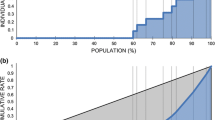Abstract
Studying crime trends and tendencies is an important problem that helps to identify socioeconomic patterns and relationships of crucial significance. Finite mixture models are famous for their flexibility in modeling heterogeneity in data. A novel approach designed for accounting for skewness in the distributions of matrix observations is proposed and applied to the United States crime data collected between 2000 and 2012 years. Then, the model is further extended by incorporating explanatory variables. A step-by-step model development demonstrates differences and improvements associated with every stage of the process. Results obtained by the final model are illustrated and thoroughly discussed. Multiple interesting conclusions have been drawn based on the developed model and obtained model-based clustering partition.



Similar content being viewed by others
References
Akdemir D, Gupta A (2010) A matrix variate skew distribution. Eur J Pure Appl Math 3:128–140
Anderlucci L, Viroli C (2015) Covariance pattern mixture models for the analysis of multivariate heterogeneous longitudinal data. Ann Appl Stat 9:777–800
Atkinson AC, Riani M, Cerioli A (2003) Exploring multivariate data with the forward search. Clarendon Press, Oxford
Banfield JD, Raftery AE (1993) Model-based Gaussian and non-Gaussian clustering. Biometrics 49(3):803–821
Box GE, Cox DR (1964) An analysis of transformations. J R Stat Soc Ser B 26(2):211–252
Browne RP, McNicholas PD (2015) A mixture of generalized hyperbolic distributions. Can J Stat 43(2):176–198
Cabral C, Lachos V, Prates M (2012) Multivariate mixture modeling using skew-normal independent distributions. Comput Stat Data Anal 56(1):126–142
Chen J, Gupta A (2005) Matrix variate skew normal distribution. Statistics 39:247–253
Dempster AP, Laird NM, Rubin DB (1977) Maximum likelihood for incomplete data via the EM algorithm (with discussion). J R Stat Soc Ser B 39(1):1–38
Draper NR, Cox DR (1969) On distributions and their transformations to normality. J R Stat Soc B 31:472–476
Fraley C, Raftery AE (2002) Model-based clustering, discriminant analysis, and density estimation. J Am Stat Assoc 97:611–631
Franczak BC, Browne RP, McNicholas PD (2014) Mixtures of shifted asymmetric Laplace distributions. IEEE Trans Pattern Anal Mach Intell 36(6):1149–1157
Gallaugher M, McNicholas P (2017) A matrix variate skew-t distribution. Stat 6:160–170
Grubesic T (2006) On the application of fuzzy clustering for crime hot spot detection. J Quant Criminol 22:77–105
Harries K (1976) A crime based analysis of 729 American cities. Soc Indic Res 2:467–487
Krzanowski WJ, Marriott FHC (1994) Multivariate analysis, part I: distributions, ordination and inference. Halstead Press/Edward Arnold, New York/London
Lee S, McLachlan GJ (2013) On mixtures of skew normal and skew \(t\)-distributions. Adv Data Anal Classif 7(3):241–266
Lee S, McLachlan GJ (2014) Finite mixtures of multivariate skew \(t\)-distributions: some recent and new results. Stat Comput 24(2):181–202
Lin TI (2009) Maximum likelihood estimation for multivariate skew normal mixture models. J Multivar Anal 100(2):257–265
Lo K, Gottardo R (2012) Flexible mixture modeling via the multivariate \(t\) distribution with the Box–Cox transformation: an alternative to the skew-\(t\) distribution. Stat Comput 22(1):35–52
Manly BFJ (1976) Exponential data transformations. J R Stat Soc Ser D 25(1):37–42
McLachlan GJ, Peel D (2000) Finite mixture models. Wiley, New York
McNicholas P, Murphy T (2010) Model-based clustering of longitudinal data. Can J Stat 38:153–168
Melnykov V (2012) Efficient estimation in model-based clustering of Gaussian regression time series. Stat Anal Data Min 5:95–99
Melnykov V (2016) Model-based biclustering of clickstream data. Comput Stat Data Anal 93C:31–45
Michael S, Melnykov V (2016) Finite mixture modeling of Gaussian regression time series with application to dendrochronology. J Classif 33:412–441
Reich B, Porter M (2015) Partially-supervised spatiotemporal clustering for burglary crime series identification. J R Stat Soc A 178:465–480
Schwarz G (1978) Estimating the dimensions of a model. Ann Stat 6(2):461–464
Viroli C (2011a) Finite mixtures of matrix normal distributions for classifying three-way data. Stat Comput 21:511–522
Viroli C (2011b) Model based clustering for three-way data structures. Bayesian Anal 6:573–602
Viroli C (2012) On matrix-variate regression analysis. J Multivar Anal 111:296–309
Yeo I-K, Johnson RA (2000) A new family of power transformations to improve normality or symmetry. Biometrika 87:954–959
Zhu X, Melnykov V (2018) Manly transformation in finite mixture modeling. Comput Stat Data Anal 121:190–208
Acknowledgements
The research is partially funded by the University of Louisville EVPRI internal research grant from the Office of the Executive Vice President for Research and Innovation.
Author information
Authors and Affiliations
Corresponding author
Electronic supplementary material
Below is the link to the electronic supplementary material.
Rights and permissions
About this article
Cite this article
Melnykov, V., Zhu, X. Studying crime trends in the USA over the years 2000–2012. Adv Data Anal Classif 13, 325–341 (2019). https://doi.org/10.1007/s11634-018-0326-1
Received:
Revised:
Accepted:
Published:
Issue Date:
DOI: https://doi.org/10.1007/s11634-018-0326-1




